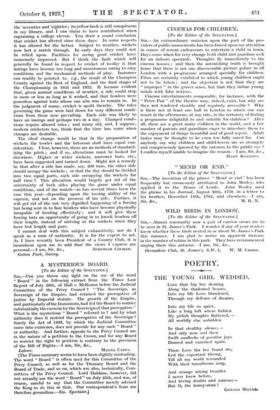CRICKET IN THE 'SEVENTIES.
[To the Editor of the SPECTATOR.] Stn,—I will comply with your invitation to write something inspired by an article upon Cricket in the Spectator of September 8th. It is so easy to comment, so difficult to suggest changes likely to materialize advantageously. Lilly- white's Cricketers' Annual was a well-known handbook in the 'seventies and 'eighties ; its yellow back is still conspicuous in my library, and I can claim to have contributed when captaining a college eleven. You draw a sound conclusion that cricket has altered since those days. In some respects it has altered for the better. Subject to weather, wickets now last a match through. In early days they could not be relied upon. Facilities for seeing good cricket have immensely improved. But I think the fault which will generally be found in respect to cricket of to-day is that innings have become too long and monotonous owing to easy conditions and the mechanical methods of play. Instances can readily be pointed to, e.g., the result of the Champion County against the Rest of England, and the final stages of the Championship in 1921 and 1922. It became evident that, given normal conditions of weather, a side could stop in more or less as long as it wished, and that bowlers were powerless against bats whose one aim was to remain in. In the judgment of many, cricket is spoilt thereby. The rules governing the game were laid down for very different condi- tions from those now prevailing. Each side was likely to have an innings and perhaps two in a day. Changed condi- tions require altered rules ; and many old, and, I suppose, modern cricketers too, think that the time has come when changes are desirable.
The ideal change would be that in the preparation of wickets the bowler and the batsman shall have equal con- sideration. I fear, however, there arc no methods of standard- izing the pitch ; and if so, alterations must be looked for elsewhere. Higher or wider wickets, narrower bats, etc., have been suggested and turned down. Might not a remedy be that after a side has made, say, 200 runs, the other side should occupy the wickets ; or that the day should be divided into two equal parts, each side occupying the wickets for half time ? This alteration would largely get rid of the uncertainty of both sides playing the game under equal conditions, and of the match—as has several times been the case this year—depending upon the tossing ability of the captain, and not on the prowess of his side. Further, it will get rid of the not very dignified happening of a forcing bat being sent in to face bowlers who have become physically incapable of bowling effectively ; and it will give these forcing bats an opportunity of going in to knock bowlers off their length, instead of arriving at the wickets when they have lost length and pace.
I cannot deal with this subject exhaustively, nor do I speak as a man of authority. It is for the expert to act. As I have recently been President of a County Club, it is incumbent upon me to add that the views I express are











































 Previous page
Previous page